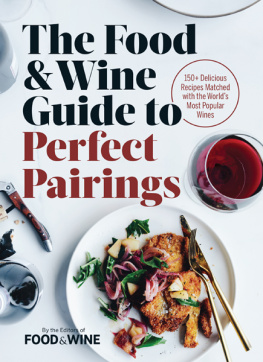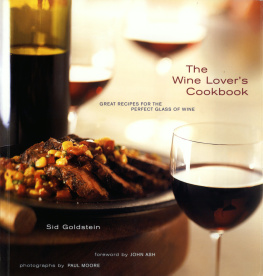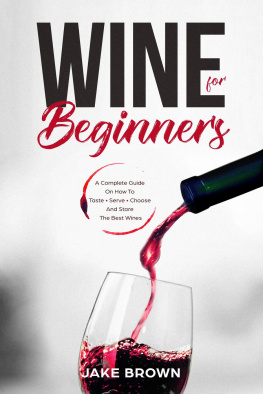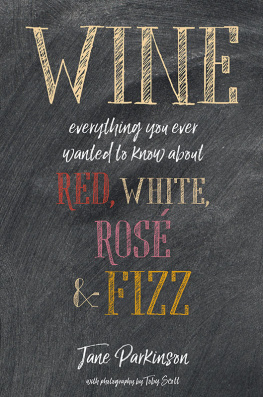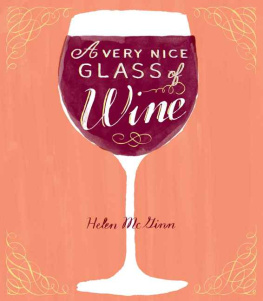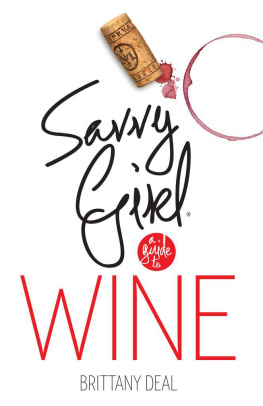Chilling Wine
staying cool is a good idea

WHATS THE BEST WAY TO COOL WINE DOWN?
The quickest way is to put it in a bucket or tub with a mixture of ice and water (ice alone is inefficient). A bottle of wine should chill well in about half an hour. The next-best way is in the fridge, which can take between an hour and an hour and a half.
HOW ABOUT THE FREEZER?
Its not that much quicker, and theres always the chance that youll forget it, the bottle will crack from the expanding liquid, and youll end up with wine slush.
WHAT WINES SHOULD I CHILL?
Most whites should be well chilled, with the exception of Chardonnay, which should be just lightly chilled so it doesnt lose its complexity. Ross are more refreshing when chilled.
HOW ABOUT REDS?
Just a few. Light red wines like Beaujolais, Gamay, Chinon, and Valpolicella benefit from a bit of a chillthe coolness increases their liveliness.
Cooking with Wine
wine is a cooks best friend

WHAT WINE SHOULD I USE FOR COOKING?
Not the most expensive, and not the cheapest (wine becomes concentrated with heat, so if its flawed, cooking makes it worse). Go for good basic flavor and intensitylight wines for light foods, heavier wines for meat stews or spicy dishes.
WHAT ABOUT THE ALCOHOL?
When wine is heated, the alcohol cooks off fairly quicklythe boiling point of alcohol is quite a bit lower than that of water.
WHATS COOKING WINE?
Wine labeled cooking wine is basically cheap wine that has had salt added to it. Its not really a bargain and is not very tasty. Remember, if its not fit to drink, its not fit to cook with.
WHEN DO I ADD WINE?
Always add wine at the beginning of cooking, so the alcohol cooks away and maximum flavor develops. Use Champagne with restraintit can make a dish overly tart.
Dinner Parties
hints for stress-free entertaining

Done right, dinner parties are wonderfully convivial fun; done wrong, theyre sheer hell for hosts and guests alike. Here are some guidelines for creating a successful occasion.
MAKE SURE YOU HAVE enough glasses. Never double them upwho needs to stop everything while you wash and dry them to pour another wine?
WRITE DOWN A TIMETABLE for the food preparation, be realistic about the timing, and then add ten minutes to every step for insurance.
WEAR COMFORTABLE SHOES while you cook. Nothing tires you out like hurting feet.
ALLOW ENOUGH TIME for the white wines to chill properly. A bottle of white wine will chill well in half an hour in ice, an hour in the fridge; several bottles of wine will take even longer. Allow at least one hour in ice for four bottles or more.
SET THE TABLE in advance.
MAKE AS MUCH AHEAD as possible. This is where a cold first course comes in handy, and dessert should be made ahead, too.
Accessories
the right hardware helps

CORKSCREW
Most important is that the screw is an open spiral with a sharp point that goes cleanly into the cork and gets a good grip. The best corkscrew looks like a pocketknife. Known as the waiters friend, its easy to carry and to operateyou can pull a cork quickly with a lever action, and its sharp bits fold away.
DECANTER
Decanters are useful and attractive; they help open up wines aroma and flavor by allowing a bit of the alcohol and tannin to blow off, which can be useful in young wines. Choose one that isnt too heavy and that is easy to pour from. A glass stopper wont provide a perfect seal, so wine should never be stored in a decanter.
CHILLER
Essential equipment. It should be big enough to hold a bottle, ice, and water. Terra-cotta or double-walled coolers are effective once the wine is cold.
STOPPER
Recorkers for Champagne and other sparkling wines preserve the bubbles for as long as two days. Choose either a simple plastic type topped by a lever or a stainless steel type that clamps on tightly.
Wine & Cheese
perennial partners

WHY ARE WINE AND CHEESE NATURAL ALLIES?
Aside from their complementary flavors, they are the product of similar fermentations and often have similar types of acidity in common, making them compatible.
WHEN SHOULD THEY BE SERVED?
Wine and cheese are a good match any time. As a snack or before a meal, light red or white wines go well with firm, mild cheeses like Monterey or Sonoma Jack, Emmenthal, Edam, or Jarlsberg. After dinner, things get more serious.
DONT RED WINES GO BEST WITH STRONG CHEESE?
Not necessarily. Red Bordeaux and aged Gouda is a formal, classic after-dinner pairing, but most of the time sweet white wines are the best matchSauternes or Late-Harvest Rieslings with Roquefort, Gorgonzola, or Stilton, for example.
HOW ABOUT FORTIFIED WINES?
They make first-rate partners, too. Port, either red or tawny, is great with various blue cheeses, and the rich, golden Muscat de Beaumes-de-Venise or Sicilian Muscats are lovely with aged Parmesan or pecorino.
Storing Wine
mellowing out

DOES ALL WINE IMPROVE WITH AGE?
Not everyday, inexpensive wines. Most wine, red or white, is ready to drink when its bought. Those that benefit and mellow are fine, full-flavored wines such as Cabernet Sauvignon, Zinfandel, red Bordeaux and Burgundy, Barolo, and reserve Rioja and Chianti.
HOW ABOUT WHITE WINES?
White wines like Chardonnay, Sauvignon Blanc, and Riesling often benefit from at least short-term aging, until about two or three years after the vintage date.
DO I NEED A CELLAR TO STORE WINE?
Not really. Wine is affected by heat, light, and vibration, so it should be stored out of the kitchen and away from machinery such as a refrigerator or washing machine. Boxing up the wine will keep out light well enough, and a closet is usually adequate storage space.
WHATS THE BEST TEMPERATURE?
The ideal temperature for long-term storage is between 42 and 65 degrees Fahrenheit; at between 65 and 73 degrees, the wine isnt harmed but will mature sooner over several years. For short-term aging, that range shouldnt be a problem.


